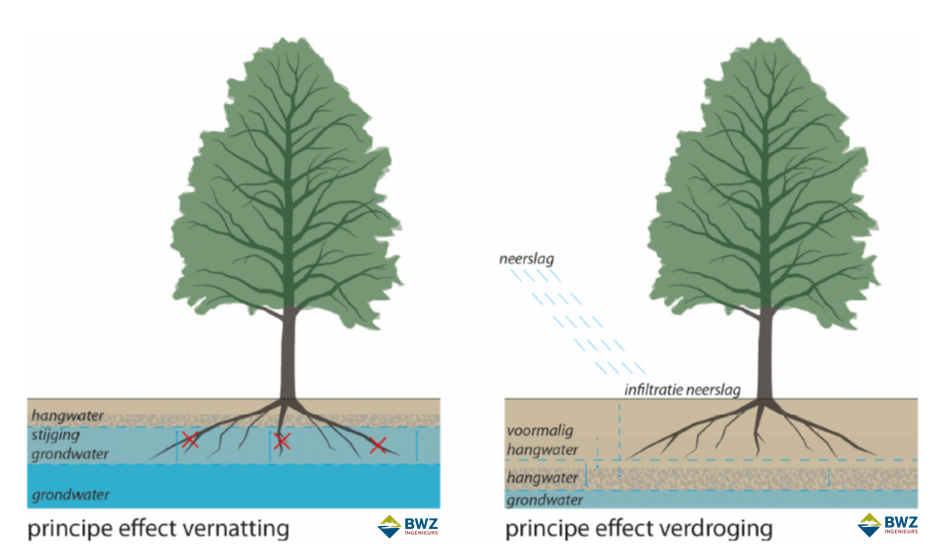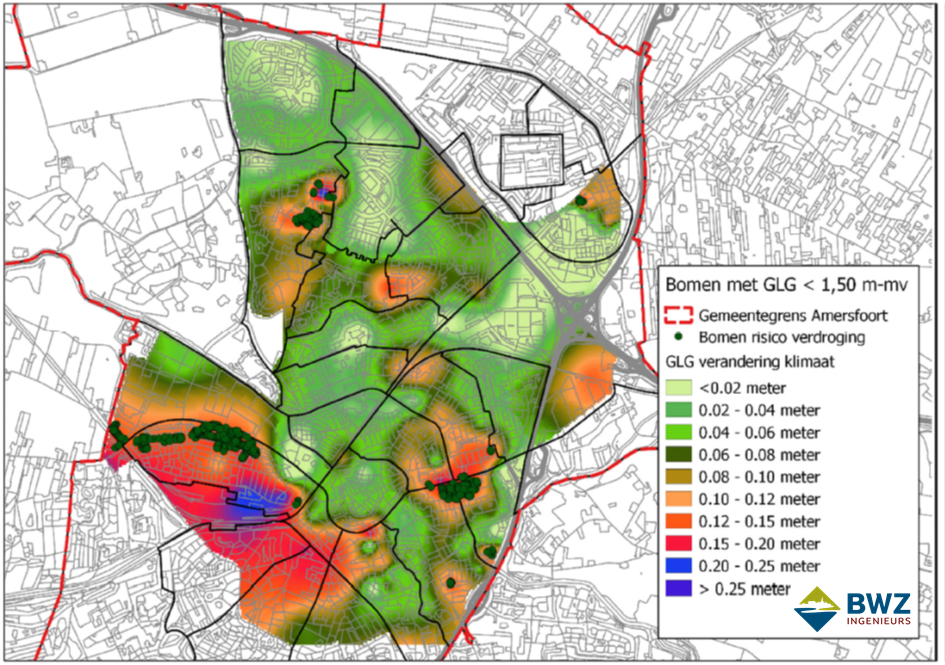The impact of climate change on trees in the municipality of Amersfoort
In 2014, the municipality of Amersfoort and the Vallei en Veluwe district water board signed the so-called “Blue Deal, water-resilient Amersfoort”. This agreement is aimed at the collective implementation of the Amersfoort Climate Agenda Water, intended to ensure that the city of Amersfoort will be climate-proof by 2030/2050. One of the projects set out in this agenda is “Study into the impact of and potential measures relating to phreatic decline and heat stress on greenery and ecology”. As a first substantiation, the potential impact of climate change on the trees within the Amersfoort urban area has been mapped out. According to this study, some 2000 trees are prone to damage if optimum habitat conditions are not factored in.
The study has elaborated the potential impact of climate change on the trees in the municipality of Amersfoort, with an emphasis on the potential impact of soil becoming wetter or drier as a result of climate change and the impact of changing temperatures. In addition, other effects have been studied, such as shifting growing seasons, frost damage, changing wind climates, diseases and infestations, ice control, ecological shifts, and changing (increasing) invasive behaviour of exotic species.
 Image: Principles underpinning the wetting effect (left) and the drying effect (right)
Image: Principles underpinning the wetting effect (left) and the drying effect (right)
The effect analyses were based on the digital tree database of the municipality of Amersfoort and local data currently available regarding the expected climate effects: maps showing calculated changes in Average Highest Groundwater Level (AHGL) and Average Lowest Groundwater Level (ALGL), and maps pertaining to the occurrence of heat stress within the municipality. Analyses have thus been conducted for some 57,000 trees out of the total tree database comprising some 87,000 trees.
Results
The analysis has shown that if optimisation of habitat conditions is not factored in, some 2000 trees will be prone to damage.
 Image: Trees at risk of dehydration due to changing ALGL
Image: Trees at risk of dehydration due to changing ALGL
The most common species at risk of declining phreatic levels are:
- Black alder
- Common oak
- Common ash
- Common linden
- Small-leaved linden
The most common species at risk of rising groundwater levels are:
- Common oak
- Common ash
- Black alder
- Plane tree
- Small-leaved linden
With respect to the impact of higher temperatures, only a minor proportion of the trees appear to be susceptible to heat stress at high “heat degree” locations. The main cooling effect of trees is generated by the interception of solar rays by the canopy (shadowing). An analysis has shown the volume of greenery in a neighbourhood (expressed in the percentage of crown surface area or in the number of trees per hectare) to be indicative of differences in heat degree, as calculated according to the climatopes method.
A general conclusion is that a direct impact of climate change on trees is not to be expected in the near future. For the time being, tree species in urban areas are sufficiently flexible or “mouldable” to cope with the consequences of the anticipated climate changes. A prerequisite is that optimisation of habitat conditions such as sufficient hydration and sufficient drainage must already be factored in, more so than in the past. In addition, it is important to maintain or, as the case may be, expand the diversity of the tree stock and to replace in due course species found to be (extremely) susceptible to a particular aspect.
 Image: Principles for an optimum habitat (left) and for a limited habitat (right)
Image: Principles for an optimum habitat (left) and for a limited habitat (right)
As a follow-up to the effect analyses conducted, this study has also addressed any required and/or potential measures to improve tree vigour/health and to combat dehydration, water saturation of the soil, and heat stress. In addition, measures have been outlined that address shifting growing seasons, diseases and infestations, ice control, ecological changes or shifts, and wind and storm (see summary). The outcomes of the study will be used for climate-proofing the municipal tree stock.
Lessons learned from the project
In view of the scale level of the maps used and the lack of specific information on the habitats of individual trees, the results of the analyses must be regarded as indicative. The elaborations do not warrant any conclusions regarding individual trees; the study involved a quick scan intended as an initial finger exercise to gain more insight into the nature and scope of the potential impact of climate change on trees. Important points of departure in this respect are the maintenance and/or expansion of the diversity of the tree stock and the gradual replacement of tree species found to be (extremely) susceptible to a particular aspect. Increased diversity in the selection of tree species will enhance flexibility to cope with and resilience against changing environmental effects, while reducing average vulnerability to epidemic diseases and infestations.
Contact persons
M. van Dorst
BWZ-ingenieurs B.V.
m.vandorst@bwz-ingenieurs.nl
06 21 633 730
Jan van ’t Klooster
Gemeente Amersfoort
